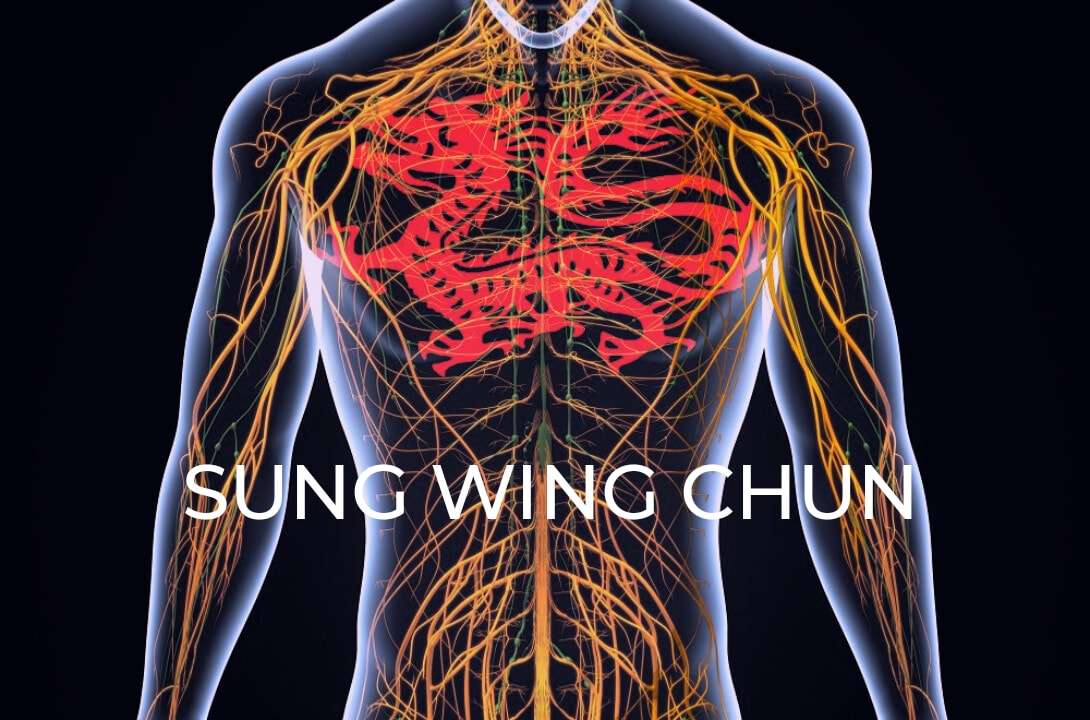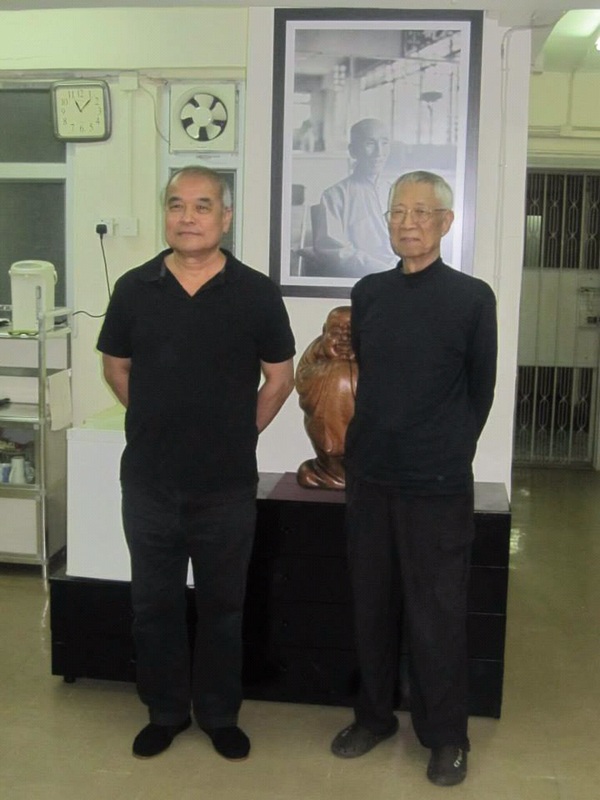Fook Sau
6/21/2015
Wing chun as a fighting art is based on relatively basic concepts, however people tend to over complicate it because they have not established the basic preconditions necessary to start chi sau. Essentially we want use our arms (or legs) to either deliver our body mass into our opponent, or to use those limbs to use the body mass to protect us. Chi sau is an exercise in doing this simultaneously so the opponent is always having to deal with a force pointing towards their centre. The wheels fall off for people when they are only able to utilise a small amount of their mass, which tends to lead to an exercise in aligning in straight lines behind the fist: very powerful in one direction but this requires constant adjustment which affects your balance and provides an opportunity to the opponent. My believe is that this is a very common method, hence the prevalence on youtube of videos showing people chasing hands. If your focus is on hands, you have missed the point of the exercise as you risk the opponent adjusting their body mass to develop overwhelming power.
Once a student can relax their joints sufficiently, it becomes relatively easy to release a tan sau and even roll into bong sau. In a sense I think that people accept that this easier to do than fook sau because they can see something happening, they can feel it and therefore are satisfied that their actions are responsible for the effect on the partner. With a fook sau, my experience is people get lost in the desire for movement/reaction and forget what the training objective is. If two inexperienced students are put together it will quickly develop into one person either holding their fook sau down to restrain the partner or alternatively their wrist being dragged across their body as they seek to 'stick' to the opponent. The answer for this is always return to the training objectives. First pay attention to your relaxed structure (let go), second point your mass at the whole opponent. We need to remember that the goal is more than restraining their forearm, if you set yourself up properly first you not only restrict their ability to produce power, you allow yourself to move your own joints with less effort and deliver your mass. It all sounds simple but it is not easy. I have heard it told back to me many times how difficult it is to concentrate all of the time, essentially having to be in the moment throughout a movement is hard (at first at least). You can cheat, you can throw out punches, lean, push and pull, but that is all risky guess work which is only likely to work on a compliant or smaller partner trained in the same drills as yourself. The satisfaction comes in being mindful through the movements, allowing it to happen based on the basic instructions you give your body, without the micro management of constant forearm alignment. It is impossible to teach what a fook sau is in writing, practical experience is the best teacher. A tip I can give is do not get hung up on the names of techniques, bong, tan, fook, jut etc, basically your hand is either on the inside or outside and that in itself will determine what response your body will decide is appropriate. https://youtu.be/v1xGfVeYVBU
0 Comments
Chu Shong Tin: The Last Goodbye
6/12/2015
The last time Mark and I visited Hong Kong was March 2014, 4 months before Sigung passed away. I knew before that it was likely to be my last trip, not because I was aware of Sigung's illness, but because I thought my own wing chun journey was coming to an end. My training had stagnated and I was not sure how I could move on. Aside from Mark and Jon the other people I was training with were self limiting in their motivation and seemed to actively avoid chi sauing with us. The trip was one last chance; find a better way or pack it all in.
Unlike earlier visits I decided that I would not seek to test others or myself as that is a self defeating route. This time I would listen, feel and take in as much as I could no matter how much my ego wanted to have a go. Even if I though I could match others by adding a bit of muscle, that was something I wanted to leave behind, now I wanted to sense why they could practice so effortlessly. When I first saw Sigung it was a shock, he was about 74 when I first met him but now 80 his age was finally showing. However as soon as he saw us his familiar smile lit up the room and shuffled over with friendly greetings. Perhaps his power had diminished, but not enough for me to really tell. His demonstrations were effortless, unstoppable and his passion burned as he gave detailed explanations. Although I cannot speak cantonese, I would stand transfixed as if his words would somehow magically sink in. Fortunately I had Mark to act as translator, because of his relationship with Sigung I was always able to to get to the heart of the demonstrations, have my questions answered and experience the sensations of his touch. There were occasionally other people who would try to 'test' Sigung, somehow oblivious to his ill health, but he was quite capable of batting them away with ease. On one occasion a visitor was also given a lesson in manners from a protective Nima King, but Sigung watched on oblivious. There were many highlights of the trip, all enhanced by approaching each experience as a chance to learn. Each afternoon was spent with Sisuk Ma Kee Fai, one of Sigung's senior students and one of the most humble and skilled men you can meet; a morning learning from my friend John Kaufman about his interpretation of the Chu Shong Tin method; a lesson from Sisuk Eddie Chan (see Ideas wing chun on Youtube) with an amazing demonstration of Bil Jee power, and after training with Sigung each evening there was a trip to the pub with big brother Kris Collins. He is an encyclopedia of knowledge about Chu Shong Tin wing chun and I wish he would return to the UK to teach. The true highlight though was training, watching and being inspired by Sigung. Inspiration is truly the word as it flowed from him and everything he did. The last session was the best, shortly before the end he came up behind me and with a few touches of my shoulder he was lifting me up by the elbow but I could not feel a thing. He had the ability to notice a release of a muscle from across a room and hone in on it. The final highlight was a simple handshake just as I was leaving, in the past I had always given a polite bow but this time he offered his hand and I took it eagerly. I am sure for him it meant nothing, I was just another visitor from overseas, but there was clearly an element of a final farewell which touched me. I returned to the UK fully inspired, however things had not changed in Sheffield and so Mark, Jon and I decided that once Sigung had passed it would be time for us to start our own school. Before leaving Hong Kong this had been suggested several times to us and we knew it was the right thing to do. Unfortunately on 28 July 2014 the news of his death came. He has been battling cancer for many years but despite that he continued to teach until the week before his death. I was on holiday in Canada and reference to the event on Facebook hit me like a punch to the stomach. For myself I was only a minor bit part near the end of his life, but my grief was for his family and those would trained with him daily for so many years. At first I could not even talk about it and only after a day did I show my partner an email confirming the news in order to explain my sadness. Sigung left a great legacy, in video, books and with his students. He was never matched (no one came close), but his inspiration lives on and this accounts for the reason people contact our club from across the UK and Europe wishing to know more about him and experience his training process. To honour his memory we should follow his example as best as we are capable. We should seek to understand our bodies, use as little force as possible and be honest with ourselves about our abilities. The wing chun taught by Sigung was a true gift to us, something that can grow with us through life and something we should treasure. It is not just our wing chun or other martial arts which recognise that our habitual tension restricts bodies’ ability to produce effortless power, it is the focus of many none martial pursuits such as yoga, Pilates, Feldenkrais, the Alexander Technique etc. A stumbling block we each encounter even before we start a new discipline is that we are already sending signals to our muscles, some conscious, some unconscious and some habitual and our brains are having to interoperate those signals to check if our body is doing as it is told. A problem identified by FM Alexander is that our sense of self is already faulty (he called it debauched kinesthetic awareness); we cannot rely on the sensory feedback we are receiving to let us know if our instructions are working. This is why trying to stand up straight does not work, or pulling your shoulders back. It causes problems for other areas in your body, creates lack of balance and your body soon gets used to it and you do not recognise the damage you are doing.
Alexander created his own technique for dealing with how to ‘use’ our bodies. In wing chun we rely on standing practice, work on the forms and the hands-on guidance of an experienced teacher. This method of cultivating an awareness of our bodies helps release tension and tends to lead to better ‘use’ on its own. Something I have been interested in over the years is abstract imagery as a way of cultivating muscular release. What this helps demonstrate is that we already have images of how our bodies work imposed on our minds which restrict our movements and sensations. The images might not work for everyone, but sometimes an idea is just enough to encourage a release. In a sense they are not an answer to the problem, but they do help to identify where the problem is. The images below come either from the Franklin Method, or a book called the Tai Chi Imagery Workbook by Martin Mellish. Imagery has always been used in martial arts, we have snake, crane, monkey styles etc, we also have techniques such as lady looks in the mirror (tan sau in wing chun) or my favorite ‘monkey steals the plums’ (you can work that one out yourself). The idea is not to try to ‘do’ the image, it is to allow the though to enter your mind and body and then allow what release is appropriate. The trick is not to chase the feeling, just use it as a signpost. |
AuthorKeeping you up to date with what is happening in class Archives
July 2024
Categories |











 RSS Feed
RSS Feed